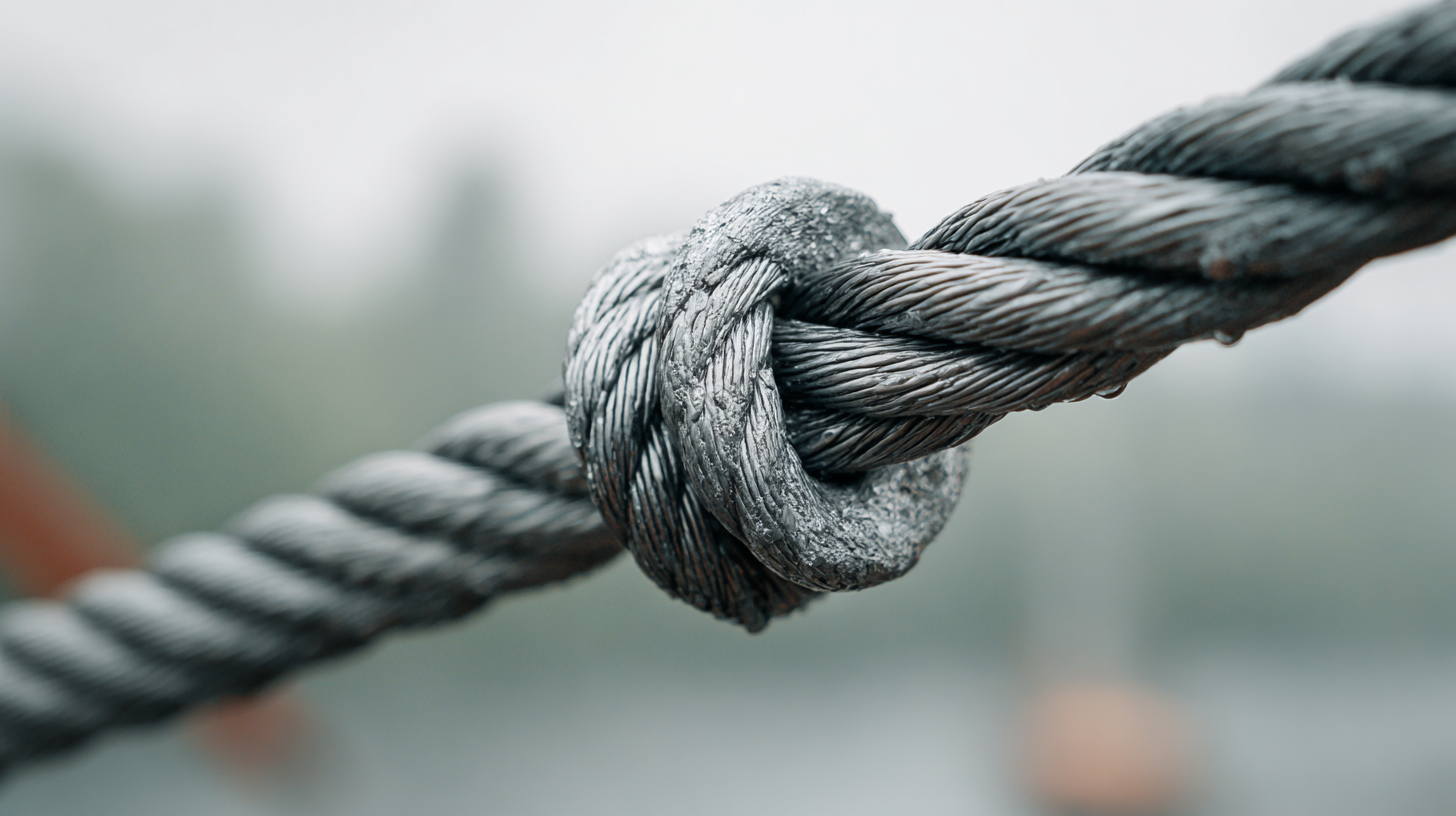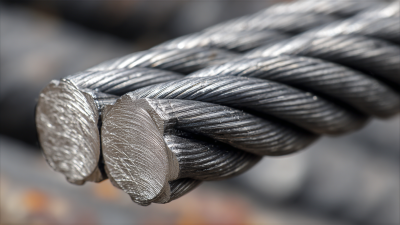 In the realm of lifting and rigging, the significance of Wire Rope End Fitting cannot be overstated, as it directly influences both safety and performance rankings across various industries. According to recent industry reports, improper or faulty wire rope end fittings contribute to approximately 25% of equipment failures, highlighting the critical need for reliable components in safety-sensitive applications. Moreover, the Global Wire Rope Market is projected to reach USD 4.53 billion by 2027, with end fittings playing a pivotal role in ensuring optimal load capacity and operational efficiency.
Understanding the selection, installation, and maintenance of wire rope end fittings is essential for professionals who aim to enhance safety standards and operational effectiveness. This article explores the best practices and essential knowledge needed to navigate this critical component of wire rope systems, ensuring that users can make informed decisions that bolster performance and safety in their operations.
In the realm of lifting and rigging, the significance of Wire Rope End Fitting cannot be overstated, as it directly influences both safety and performance rankings across various industries. According to recent industry reports, improper or faulty wire rope end fittings contribute to approximately 25% of equipment failures, highlighting the critical need for reliable components in safety-sensitive applications. Moreover, the Global Wire Rope Market is projected to reach USD 4.53 billion by 2027, with end fittings playing a pivotal role in ensuring optimal load capacity and operational efficiency.
Understanding the selection, installation, and maintenance of wire rope end fittings is essential for professionals who aim to enhance safety standards and operational effectiveness. This article explores the best practices and essential knowledge needed to navigate this critical component of wire rope systems, ensuring that users can make informed decisions that bolster performance and safety in their operations.
Wire rope end fittings play a crucial role in ensuring load management efficiency across various industries. According to a report by the Wire Rope Technical Committee, improperly selected or installed end fittings can lead to a reduction in the overall strength of the wire rope system by up to 30%. This significant loss underscores the necessity of choosing the right fittings to maintain safety and performance standards. The application of appropriate end fittings not only maximizes the load-carrying capacity but also ensures the longevity of the wire rope itself, accounting for predictable wear and tear under operational conditions.
Moreover, the integration of advanced designs in wire rope end fittings has been shown to enhance operational safety. A study conducted by the Lift Safety Association revealed that the usage of specialized end fittings can reduce the risk of catastrophic failures by approximately 25%. These fittings facilitate better load distribution and minimize stress concentrations, which are often the culprits behind premature equipment failures. By prioritizing high-quality end fittings, industries can significantly improve their load management efficiency while adhering to safety protocols, thus preventing accidents and optimizing performance outcomes.
Wire rope end fittings play a crucial role in the overall safety and performance of lifting and rigging applications. Various factors influence the safety ratings of these fittings, such as material strength, design specifications, and manufacturing standards. High-quality materials like steel or alloys can withstand significant loads and resist wear, thereby enhancing their performance and longevity. Additionally, adherence to industry standards during manufacturing ensures that the end fittings are reliable under operational stress.

Tips for selecting wire rope end fittings include examining the load rating and ensuring it aligns with your specific application requirements. Always opt for fittings that meet or exceed relevant safety standards, such as those set by ASME or ISO. Furthermore, regular inspection and maintenance of end fittings can prevent failures and ensure safety over time. Check for signs of wear, corrosion, and deformation, as these can compromise the integrity and safety of the fittings.
Another significant aspect is the installation process. Proper installation is key to achieving optimal performance and safety ratings. Employ appropriate tools and techniques, and consider consulting with a professional if you're uncertain about the installation procedure. This not only helps in ensuring safety but also maximizes the efficiency of the wire rope system.
When it comes to wire rope end fittings, selecting the right type is crucial for both safety and performance in various applications. The end fittings act as the final connection point in a wire rope assembly, and their quality directly impacts the load-carrying capacity and longevity of the entire system. According to industry research, over 50% of equipment failures in lifting applications can be traced back to improper fittings. Therefore, ensuring that the chosen end fittings meet the specific requirements of the application is paramount.
When considering wire rope end fittings, it’s essential to evaluate materials and design. For instance, composite materials are gaining popularity due to their weight-to-strength ratio and corrosion resistance, making them ideal for marine applications. Additionally, compatibility with existing rigging systems is critical; using fittings that match the specifications of lifting machinery can prevent accidents. Reports indicate that businesses that invest in the right wire rope end fittings see a significant decrease in maintenance costs and increased operational efficiency. Prioritizing these factors will lead to a safer and more effective working environment, underscoring the importance of making informed choices in wire rope end fittings selection.

Proper maintenance of wire rope end fittings is crucial to ensure their optimal performance and longevity. Regular inspection is a key practice, allowing operators to identify any signs of wear, corrosion, or deformation. Additionally, ensuring that all fittings are securely fastened can prevent unexpected failures during operation. Consider establishing a routine schedule for these inspections to maintain safety standards consistently.
**Tips:**
1. Use a lubricant specifically designed for wire rope applications to reduce friction and wear on end fittings.
2. Document all maintenance activities to track performance trends over time and anticipate necessary replacements.
Another important aspect of maintenance is cleaning. Dirt and debris can accumulate around wire rope end fittings, impairing their function. A simple wash with appropriate solvents can enhance their operational effectiveness. It's also advisable to store wire ropes in a dry environment, as moisture can lead to rust and degradation of fittings.
**Tips:**
1. Implement a cleaning regimen that coincides with routine inspections to keep fittings in good condition.
2. Follow the manufacturer's guidelines for both cleaning and lubrication to ensure compatibility and effectiveness.
This chart illustrates the performance scores of various wire rope end fittings. Analyzing these scores underlines the significance of maintaining proper end fittings to enhance safety and performance in various applications.
When it comes to using wire ropes in various applications, the installation of wire rope end fittings is crucial to ensuring both safety and performance. However, there are several common mistakes that can lead to compromised integrity and performance issues. One frequent error is neglecting to inspect the wire rope and fittings prior to installation. Any signs of wear, corrosion, or damage should disqualify the components from use to prevent catastrophic failures.
Another prevalent mistake is improper alignment during installation. When wire rope end fittings are not aligned correctly, it can lead to uneven load distribution and mechanical stress, potentially causing the fittings to fail under pressure. Additionally, failing to adhere to the manufacturer’s specifications regarding torque settings can result in loose fittings or over-tightening, both of which can drastically reduce the lifespan and reliability of the assembly. Taking the time to educate oneself on proper installation techniques and best practices is essential to maximizing safety and performance when working with wire ropes.






